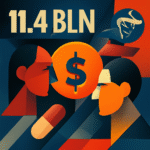Key Points
- Sharp price move: the main 2601 coking coal futures contract rose more than 10% since October 15, 2025, triggering questions about whether the rally is structural or short-lived.
- Major supply shocks: Mongolian throughput declines and regional shutdowns (notably Wuhai 乌海) tightened supply, impacting roughly 28.3 million tonnes (2,830 万吨) of capacity.
- Physical-market stress & port pricing: Mongolian Meng5 at Ganqimaodu 甘其毛都 was quoted at ¥1,098/tonne (warehouse-receipt ¥1,293/tonne) and still trading at a discount vs futures, reflecting logistics pressure.
- Domestic tightness in mine data: sample of 523 mines shows capacity utilization 85.1%, raw coal daily output 1.91 million tonnes, and inventories down (raw inventories 4.431m t, down 183,000 t; clean coking coal inventories 1.895m t, down 159,000 t).
- Outlook & trade idea: analysts expect the uptrend into November due to winter restocking and supply-side constraints; a suggested play is to go long coking coal and short coke as coke price pass-through may lag.

Coking coal rallied sharply this month and traders are asking whether the move is structural or short-lived.
Quick Take: A Sharp Rally in coking coal futures
The main futures contract for coking coal, the 2601 contract, rose more than 10% since October 15, 2025.
That jump has traders probing supply tightness, regional shutdowns, and shifting macro expectations.

Find Top Talent on China's Leading Networks
- Post Across China's Job Sites from $299 / role
- Qualified Applicant Bundles
- One Central Candidate Hub
Your First Job Post Use Checkout Code 'Fresh20'

Key Drivers: Supply concerns and regional shutdowns
Analysts point to several near-term supply-side shocks.
Zhou Minbo (Zhou Minbo 周敏波), chief analyst for ferrous metals at Guangfa Futures (Guangfa Qihuo 广发期货), told reporters that Mongolian import coal — commonly called “mengmei” or Meng coal (Mengmei 蒙煤) — production and cross-border throughput have fallen sharply.
Liu Huifeng (Liu Huifeng 刘慧峰), chief researcher for ferrous metals at Donghai Futures (Donghai Qihuo 东海期货), noted market reports that some mines in the Wuhai (Wuhai 乌海) area had stopped production.
The Wuhai stoppages affected roughly 28.3 million tonnes (2,830 万吨) of capacity, tightening fourth-quarter coal supply expectations.

ExpatInvest China
Grow Your RMB in China:
- Invest Your RMB Locally
- Buy & Sell Online in CN¥
- No Lock-In Periods
- English Service & Data
- Start with Only ¥1,000

Mongolian Coal: Port pricing, discounts, and logistics
At the Ganqimaodu port (Ganqimaodu 甘其毛都), the Mongolian No.5 raw coal (Meng5 原煤) was quoted at ¥1,098/tonne (¥1,098 RMB ($153 USD)).
The corresponding warehouse-receipt (仓单) cost was ¥1,293/tonne (¥1,293 RMB ($180 USD)).
Even after the futures rally, imported Mongolian coal still traded at a discount (贴水) versus futures, reflecting physical tightness at source and logistics pressure.

Resume Captain
Your AI Career Toolkit:
- AI Resume Optimization
- Custom Cover Letters
- LinkedIn Profile Boost
- Interview Question Prep
- Salary Negotiation Agent

Domestic mine activity and inventory trends — what the numbers say
Domestic data from a sample of 523 mines compiled by SteelUnion/SteelChain — 钢联 — through October 22 shows continued market tightness.
- Capacity utilization: 85.1%, down 2.3 percentage points week-on-week.
- Raw coal daily output: 1.91 million tonnes (191.0 万吨), down 51,000 tonnes week-on-week.
- Raw coal inventories: 4.431 million tonnes (443.1 万吨), down 183,000 tonnes week-on-week.
- Clean coking coal daily output (精煤): 761,000 tonnes (76.1 万吨), down 18,000 tonnes week-on-week.
- Clean coking coal inventories: 1.895 million tonnes (189.5 万吨), down 159,000 tonnes week-on-week.
Analysts expect mine operating rates may tick up slightly next week, but room for recovery is limited.
The headline: domestic coking coal supply remains relatively tight for now.

Wuhai and open-pit mine issues — enforcement, accidents, and output
Since the 2023 Xinjiang Alxa Left Banner (Alashanzuoqi 阿拉善左旗) New Well mine accident, resource consolidation and rectification have weighed on production.
Industry sources say roughly 70% of open-pit mines in the Wuhai (Wuhai 乌海) region remain offline for long periods.
Other open-pit sites are operating at low output.
This year, supply from open-pit mines mostly came from land-recovery (采空区治理) projects rather than normal open-pit production.
Last week regional environmental enforcement tightened.
Three land-recovery projects and several open-pit mines in the Wuda (Wuda 乌达) area suspended production again.
Although sales from some land-recovery projects resumed over the weekend, production had not resumed by the reporting date and restart timing remains uncertain.
Market participants will watch restart schedules closely.

Changing market logic: From weak demand to macro improvements
From late September into October the dominant market narrative was rising mine output and weak steel demand.
By late October that narrative shifted to improving macro expectations, hopes for “anti-involution” (fan neijuan 反内卷) policy measures, and tighter safety/environmental enforcement.
Liu Huifeng (Liu Huifeng 刘慧峰) summarized that macro improvements and supply-side constraints will likely be the main drivers moving forward.
Those factors are expected to support the uptrend in coking coal prices.

Downstream pricing, inventory behavior, and a practical trade idea
Industry sources said mainstream coke producers plan a second round of price increases, possibly to start next Monday.
Some firms are already signaling a third round of price rises.
Given recent sustained coking coal rises, coke (焦炭) prices may continue higher.
Realized coke price increases would support further coking coal gains.
Analysts expect downstream coke producers and steel mills to begin winter stockpiling in November.
That restocking would add demand for coking coal and support higher prices.
Some market participants offered a relative trade idea: go long coking coal while short coke, since coke price increases often lag coking coal.

Recent domestic price benchmarks (Fen-Wei Price Index)
According to the Fen-Wei Price Index (Fenwei Jiage Zhishu 汾渭价格指数) as of October 22:
- Shanxi (Shanxi 山西) low-sulfur main coking coal S0.7: ¥1,557/tonne (¥1,557 RMB ($216 USD)).
- Shanxi medium-sulfur main coking coal S1.3: ¥1,340/tonne (¥1,340 RMB ($186 USD)).
- S1.3 G75 main coking coal (Shanxi coal): warehouse-receipt cost ¥1,340/tonne (¥1,340 RMB ($186 USD)).

Outlook and trading view
Both Guangfa Futures and Donghai Futures analysts expect the uptrend to continue into November.
Drivers cited include winter restocking, constrained supply, and a slightly better macro backdrop.
Key risks include a faster-than-expected recovery in mine output, softness in steel demand, or a reversal in macro sentiment.

Important notes for readers and investors
- Price-to-USD conversions use an exchange rate of 1 USD = ¥7.20 (¥1 = $0.139), rounded to the nearest dollar.
- This article summarizes market commentary and published data sources for information only and is not investment advice.

What this means for investors, founders, and traders
If you’re trading or building products that touch the steel, logistics, or commodities stack, this move is a meaningful signal.
Inventory declines, port discounts versus futures, and regional mine suspensions are consistent with a supply-driven rally.
Watch three things closely:
- Restart schedules from Wuhai/Wuda — restarts would directly increase supply and could cap gains.
- Mongolian throughput and Ganqimaodu pricing — continued discounts vs futures highlight logistics stress that could sustain volatility.
- Downstream price pass-through and stockpiling — if coke producers push through prices and mills stockpile, the rally could extend into winter.
For those building models or planning hedges, consider that physical availability and logistics can lag futures moves — and that downstream price reaction often lags upstream cost moves.
Bottom line: coking coal is firing up the market because supply shocks, regional enforcement, and shifting macro expectations have tightened the physical balance heading into winter.



![China's A-Shares Roar: Market Surges on PBOC Moves & Aerospace Boom – What Investors Need to Know [FreshFromChina]](https://freshfromchina.com/wp-content/uploads/2025/05/China_s_A-Shares_Roar__Market_Surges_on_PBOC_Moves___Aerospace_Boom__What_Investors_Need_to_Know____FreshFromChina-150x150.png)


